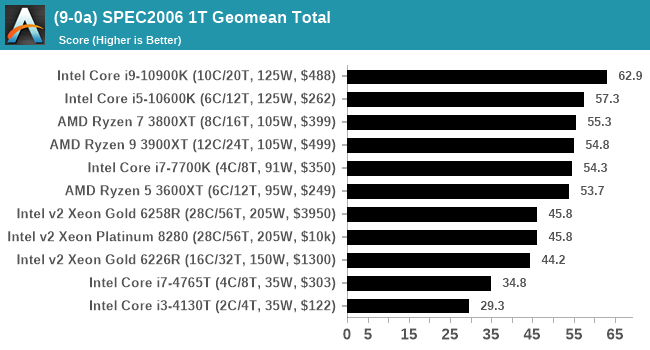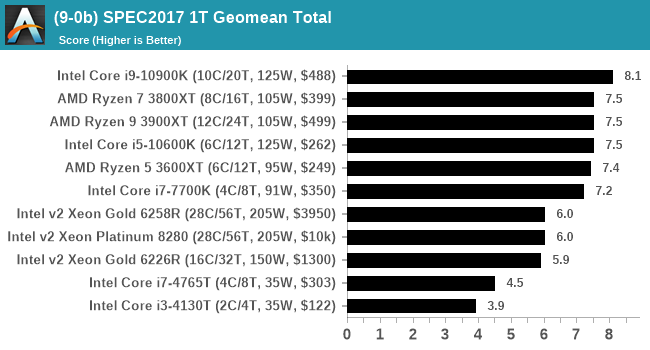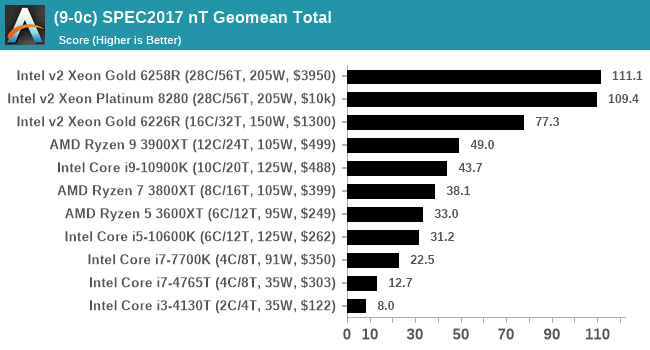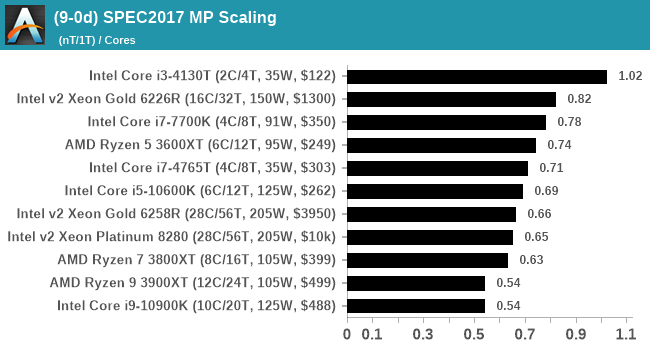Launching the #CPUOverload Project: Testing Every x86 Desktop Processor since 2010
by Dr. Ian Cutress on July 20, 2020 1:30 PM ESTCPU Tests: SPEC2006 1T, SPEC2017 1T, SPEC2017 nT
SPEC2017 and SPEC2006 is a series of standardized tests used to probe the overall performance between different systems, different architectures, different microarchitectures, and setups. The code has to be compiled, and then the results can be submitted to an online database for comparison. It covers a range of integer and floating point workloads, and can be very optimized for each CPU, so it is important to check how the benchmarks are being compiled and run.
We run the tests in a harness built through Windows Subsystem for Linux, developed by our own Andrei Frumusanu. WSL has some odd quirks, with one test not running due to a WSL fixed stack size, but for like-for-like testing is good enough. SPEC2006 is deprecated in favor of 2017, but remains an interesting comparison point in our data. Because our scores aren’t official submissions, as per SPEC guidelines we have to declare them as internal estimates from our part.
For compilers, we use LLVM both for C/C++ and Fortan tests, and for Fortran we’re using the Flang compiler. The rationale of using LLVM over GCC is better cross-platform comparisons to platforms that have only have LLVM support and future articles where we’ll investigate this aspect more. We’re not considering closed-sourced compilers such as MSVC or ICC.
clang version 10.0.0
clang version 7.0.1 (ssh://git@github.com/flang-compiler/flang-driver.git
24bd54da5c41af04838bbe7b68f830840d47fc03)-Ofast -fomit-frame-pointer
-march=x86-64
-mtune=core-avx2
-mfma -mavx -mavx2
Our compiler flags are straightforward, with basic –Ofast and relevant ISA switches to allow for AVX2 instructions. We decided to build our SPEC binaries on AVX2, which puts a limit on Haswell as how old we can go before the testing will fall over. This also means we don’t have AVX512 binaries, primarily because in order to get the best performance, the AVX-512 intrinsic should be packed by a proper expert, as with our AVX-512 benchmark.
To note, the requirements for the SPEC licence state that any benchmark results from SPEC have to be labelled ‘estimated’ until they are verified on the SPEC website as a meaningful representation of the expected performance. This is most often done by the big companies and OEMs to showcase performance to customers, however is quite over the top for what we do as reviewers.
For each of the SPEC targets we are doing, SPEC2006 rate-1, SPEC2017 speed-1, and SPEC2017 speed-N, rather than publish all the separate test data in our reviews, we are going to condense it down into individual data points. The main three will be the geometric means from each of the three suites.



A fourth metric will be a scaling metric, indicating how well the nT result scales to the 1T result for 2017, divided by the number of cores on the chip.

The per-test data will be a part of Bench.
Experienced users should be aware that 521.wrf_r, part of the SPEC2017 suite, does not work in WSL due to the fixed stack size. It is expected to work with WSL2, however we will cross that bridge when we get to it. For now, we’re not giving wrf_r a score, which because we are taking the geometric mean rather than the average, should not affect the results too much.










110 Comments
View All Comments
JustAKeyboard - Monday, July 20, 2020 - link
Need to add some Via Nano and Eden entries. How negative does the scaling go on your graphs?Ian Cutress - Monday, July 20, 2020 - link
I have a VX900-I motherboard, but last time I tried to install Windows 10, it wasn't having it.CrystalCowboy - Monday, July 20, 2020 - link
This sounds like a bleep-ton of work. What about mitigations for the various CPU compromises over the last several years?webdoctors - Monday, July 20, 2020 - link
Nice, looking fwd to the comparison of the i2500k with todays procs!Mr Perfect - Monday, July 20, 2020 - link
I especially appreciate that Bench has power consumption in it. Comparing the performance of an old 95w CPU to a new "95w" CPU isn't complete without seeing those numbers.lightningz71 - Monday, July 20, 2020 - link
Are you interested in processor donations from us for this project? I am reasonably certain that I have an i5-2400 that is in working condition on my shelf that I could gladly send your way.If you maintain an actively updated list somewhere that includes the processors that you have, and the ones that you are still looking for, and how to get them to you, I'm sure that, especially for the older ones, many of us are happy to help you out!
sorten - Monday, July 20, 2020 - link
This sounds incredible! Thank you, Ian.8aravindk - Monday, July 20, 2020 - link
Please consider open sourcing this project, not in terms of benchmarks, which you need to run yourself for authenticity, but maintain a publicly accessible wish list of processors (Like that Excel screenshot in yellow and red), I am sure people would love to donate their old processors that they were gonna chuck anyway, this would also reduce your investment by quite a bit. Also, please consider a cheap subscription as your ads are not good, people use reading modes now and I’ll gladly pay for your service.danjw - Monday, July 20, 2020 - link
I would really like to see the AMD Ryzen 2700X added.WiseSwampDragon - Monday, July 20, 2020 - link
I have an old system with a AMD Geode LX 800 CPU. I'd love to see that one in the Bench DB.